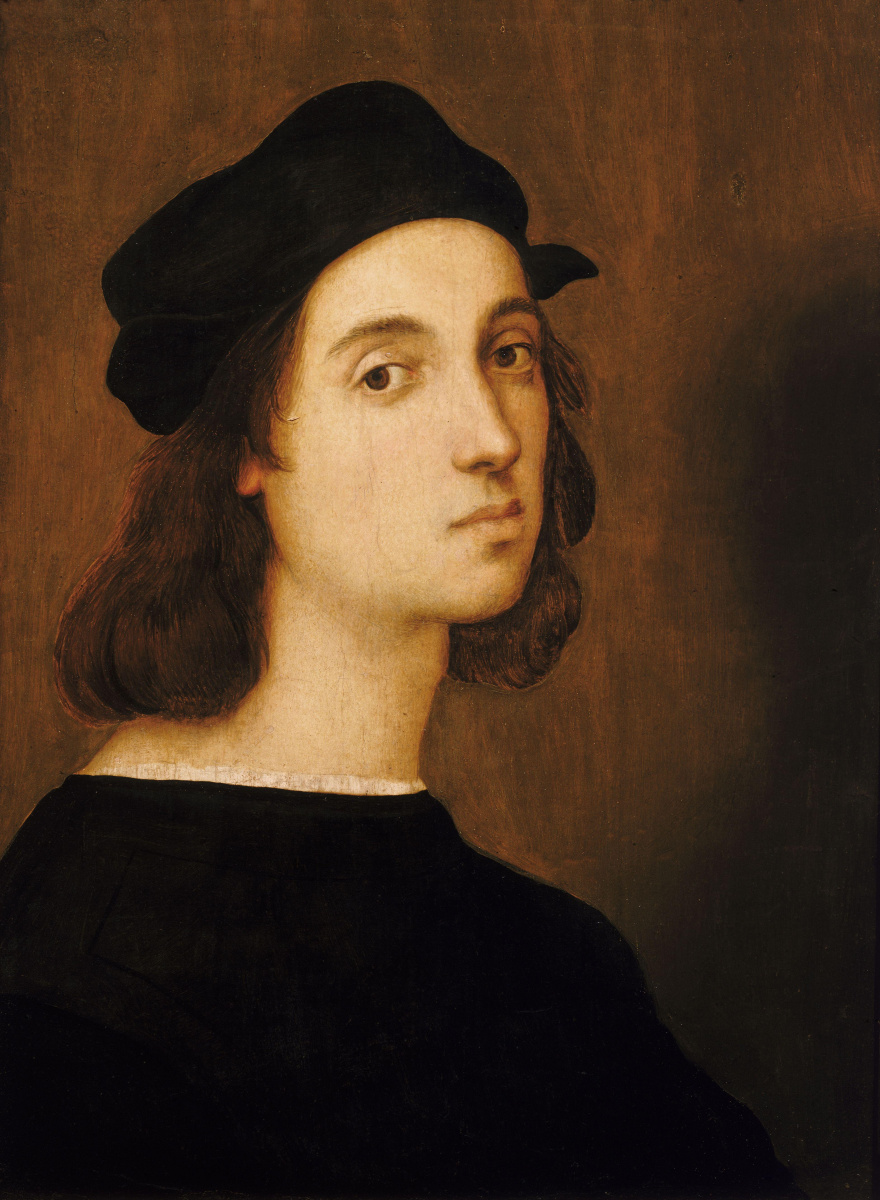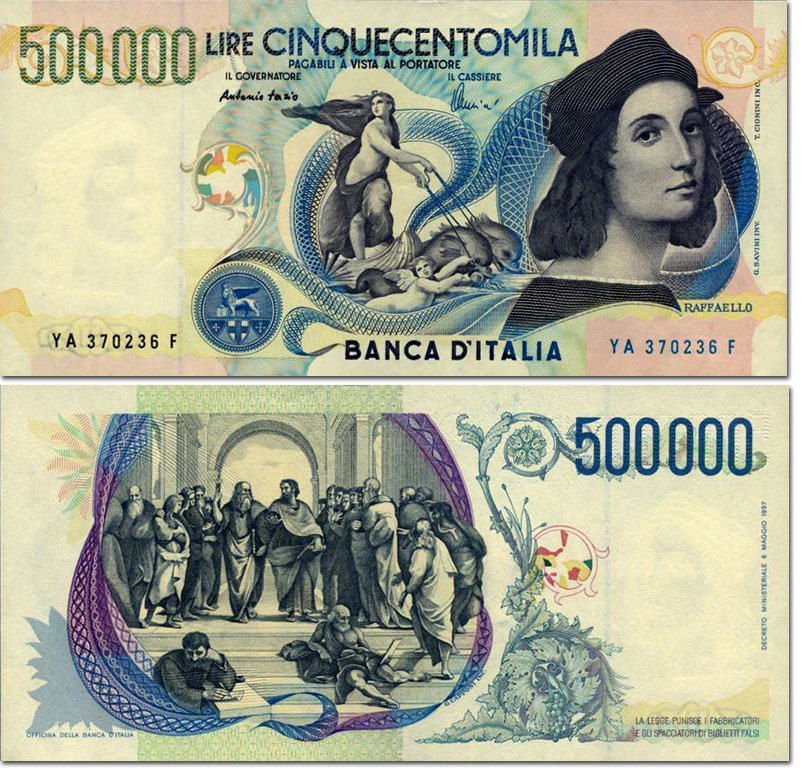log in
Enter site
Login to use Arthive functionality to the maximum
Self-portrait
Raphael Sanzio • Painting, 1506, 47.3×34.8 cm
Description of the artwork «Self-portrait»
Maybe because self portraits Raphael created very littleor because with this image of the beautiful young men so easily and is logical to relate the ideal of the Renaissance man, but this self-portrait from the Uffizi became a reference image of the artist: a rare book or an exhibition catalogue without the young Raphael in a black beret on the cover. In Italy before the entry into the Euro zone this portrait printed on 500-thousand-dollar bill: on the reverse (back side) five hundred lire was located the famous Raphael's "Athens school", but the obverse (front side) decorated fragment of a fresco of Raphael's "Galatea" and the famous self-portrait.
More surprising is that some critics call the controversial self-portrait, referring to the somewhat tangled history of change of ownership of the work and its poor preservation, compounded by clumsy restorations. And yet (despite the caveat that it can only be a copy from the lost original) an absolute majority of experts, no doubt – before us is Rafael and this is a self-portrait.
Self portrait date 1504-1506 m over the years – Rafael, therefore, is not more than 22-23 years. At this time he had already done to learn from Peruginobut instead of returning to his home in Urbino with a clear prospect following his father Giovanni Santibecome the court painter of the Dukes of Urbino, a young man at your own risk of going to Florence. The heyday of Florentine art was nearing its end, but everything is still working (before imminent departure) the great elder contemporaries of Raphael – Leonardo da Vinciand Michelangeloand Rafael knows that he has a lot to learn from them.
Soft light, placed on the half-turned face in this portrait, and the same soft, already lost proginosko the rigidity of the contours indicate that the lessons of painting by Leonardo have not been for Rafael's gift: he is studying intensively and preparing to conquer new frontiers in art. It seems, and the self-portrait was to perform a representative function: he demonstrated to potential customers, rich and noble Florentines, of the ability of the young painter.
It will take another 5-6 years, Rafael will move from Florence to Rome will be a papal artist and in the famous fresco "The school of Athens"decorating the office of Pope Julius II, will write another self portraitin the company of other great – Michelangelo, Leonardo, the architect Bramante. Put yourself in this way, the youngest and least experienced, with the giants on equal terms. Auto-the image of Raphael's "Athens school" is very reminiscent of his early self-portrait. These are the same features – the only difference is that they are in mirror image (the mirror, by the way, was one of the favorite techniques of da Vinci).
"We can safely say that he was truly an over-achiever, and quite happy person, completely loyal to the beloved, writes in the biography of Raphael the author Alexander Makhov. – It was given to him easily and without much effort. This remarkable ease he owed to his genius, which protected him from all sorts of shocks. So he looks on the famous self-portrait (Florence, Uffizi) is a confident young man with brown hair to her shoulders, regular features and enchanting eyes brown eyes in which lurks a kind of cunning".
The expression of a Raphael self-portrait interpreted in different ways. Someone, on the contrary, saw in him a directness and simple. Someone read in his eyes a bottomless sadness, akin to creative melancholy of Durer(according to the testimony of Vasari, Dürer and Raphael met once). Someone took a self-portrait of Raphael as an expression of the absolute balance and tranquility, bringing the happy character of the artist, the harmony of his paintings. Someone mentioned that the beautiful shape of the mouth of Raphael allude to its sensitivity (which is also insensitive trumpeted by Vasari), and slightly protruding lower lip gives the artist a natural stubbornness and persistence in achieving goals. But many found in the person of Rafael pleasantness, elegance, tenderness and kindness.
However, all of these exercises in physiognomy – something very subjective.
And for the sake of objectivity, we note that not all self-portrait of Raphael caused a delighted awe. For example, the famous English historian Edward Gibbon(1737-1794) described it as: "Without expression, without drawing and without colour". In addition, it was noted that the relationship between the painting of the face and neck, the wizard allows anatomical inaccuracies, is characteristic also for some other works by Raphael.
The young man in the portrait is dressed simply and strictly, and at the same time elegant. From under the black robes stands a thin white stripe gate. Hair tucked under a black beret. Its graceful appearance correlated with two important concepts of Renaissance aesthetics and the Renaissance code of conduct. The first of them graceand the second sprezzatura.
Beauty is impossible without harmony, but harmony knew differently. Leon Battista Alberti (scientist, priatel, art theorist of the Renaissance), for example, interpreted harmony as an ideal combination of parts. But the philosopher-Platonist Marsilio Ficino said: beauty is not only harmony, but also grace. What is grace? It is beauty in motion, "the brightness of the whole" presence in the body spiritualized the divine. The living embodiment of grace many called Raphael.
The second concept of sprezzatura – belongs to a friend of Raphael, diplomat and humanist Of Baldassare Castiglione. In his famous treatise "On the court", he sings of sprezzatura – quality which successful people of the world. This ability to behave as if whatever you did and whatever made up, you don't need any special effort, everything is free of stress and difficulty. A self-portrait of Raphael, in accord with the code of Castiglione, shows the viewer before him a brilliant young artist to whom everything is extraordinary, truly divine ease.
A huge talent of Raphael is not clouded, as is often the case with artists all over the history, some inward flaw. Rather, as stated by Vasari, has had a rare charm, kindness and humility – such that "at the sight of Raphael any bad mood and any vile or evil thought out of my head".
Author: Anna Yesterday
More surprising is that some critics call the controversial self-portrait, referring to the somewhat tangled history of change of ownership of the work and its poor preservation, compounded by clumsy restorations. And yet (despite the caveat that it can only be a copy from the lost original) an absolute majority of experts, no doubt – before us is Rafael and this is a self-portrait.
A self-portrait of Raphael: time and place
Self portrait date 1504-1506 m over the years – Rafael, therefore, is not more than 22-23 years. At this time he had already done to learn from Peruginobut instead of returning to his home in Urbino with a clear prospect following his father Giovanni Santibecome the court painter of the Dukes of Urbino, a young man at your own risk of going to Florence. The heyday of Florentine art was nearing its end, but everything is still working (before imminent departure) the great elder contemporaries of Raphael – Leonardo da Vinciand Michelangeloand Rafael knows that he has a lot to learn from them.
Soft light, placed on the half-turned face in this portrait, and the same soft, already lost proginosko the rigidity of the contours indicate that the lessons of painting by Leonardo have not been for Rafael's gift: he is studying intensively and preparing to conquer new frontiers in art. It seems, and the self-portrait was to perform a representative function: he demonstrated to potential customers, rich and noble Florentines, of the ability of the young painter.
It will take another 5-6 years, Rafael will move from Florence to Rome will be a papal artist and in the famous fresco "The school of Athens"decorating the office of Pope Julius II, will write another self portraitin the company of other great – Michelangelo, Leonardo, the architect Bramante. Put yourself in this way, the youngest and least experienced, with the giants on equal terms. Auto-the image of Raphael's "Athens school" is very reminiscent of his early self-portrait. These are the same features – the only difference is that they are in mirror image (the mirror, by the way, was one of the favorite techniques of da Vinci).
Psychology and anatomy in a self-portrait of Raphael
"We can safely say that he was truly an over-achiever, and quite happy person, completely loyal to the beloved, writes in the biography of Raphael the author Alexander Makhov. – It was given to him easily and without much effort. This remarkable ease he owed to his genius, which protected him from all sorts of shocks. So he looks on the famous self-portrait (Florence, Uffizi) is a confident young man with brown hair to her shoulders, regular features and enchanting eyes brown eyes in which lurks a kind of cunning".
The expression of a Raphael self-portrait interpreted in different ways. Someone, on the contrary, saw in him a directness and simple. Someone read in his eyes a bottomless sadness, akin to creative melancholy of Durer(according to the testimony of Vasari, Dürer and Raphael met once). Someone took a self-portrait of Raphael as an expression of the absolute balance and tranquility, bringing the happy character of the artist, the harmony of his paintings. Someone mentioned that the beautiful shape of the mouth of Raphael allude to its sensitivity (which is also insensitive trumpeted by Vasari), and slightly protruding lower lip gives the artist a natural stubbornness and persistence in achieving goals. But many found in the person of Rafael pleasantness, elegance, tenderness and kindness.
However, all of these exercises in physiognomy – something very subjective.
And for the sake of objectivity, we note that not all self-portrait of Raphael caused a delighted awe. For example, the famous English historian Edward Gibbon(1737-1794) described it as: "Without expression, without drawing and without colour". In addition, it was noted that the relationship between the painting of the face and neck, the wizard allows anatomical inaccuracies, is characteristic also for some other works by Raphael.
A self-portrait of Raphael: grace and sprezzatura
The young man in the portrait is dressed simply and strictly, and at the same time elegant. From under the black robes stands a thin white stripe gate. Hair tucked under a black beret. Its graceful appearance correlated with two important concepts of Renaissance aesthetics and the Renaissance code of conduct. The first of them graceand the second sprezzatura.
Beauty is impossible without harmony, but harmony knew differently. Leon Battista Alberti (scientist, priatel, art theorist of the Renaissance), for example, interpreted harmony as an ideal combination of parts. But the philosopher-Platonist Marsilio Ficino said: beauty is not only harmony, but also grace. What is grace? It is beauty in motion, "the brightness of the whole" presence in the body spiritualized the divine. The living embodiment of grace many called Raphael.
The second concept of sprezzatura – belongs to a friend of Raphael, diplomat and humanist Of Baldassare Castiglione. In his famous treatise "On the court", he sings of sprezzatura – quality which successful people of the world. This ability to behave as if whatever you did and whatever made up, you don't need any special effort, everything is free of stress and difficulty. A self-portrait of Raphael, in accord with the code of Castiglione, shows the viewer before him a brilliant young artist to whom everything is extraordinary, truly divine ease.
A huge talent of Raphael is not clouded, as is often the case with artists all over the history, some inward flaw. Rather, as stated by Vasari, has had a rare charm, kindness and humility – such that "at the sight of Raphael any bad mood and any vile or evil thought out of my head".
Author: Anna Yesterday




